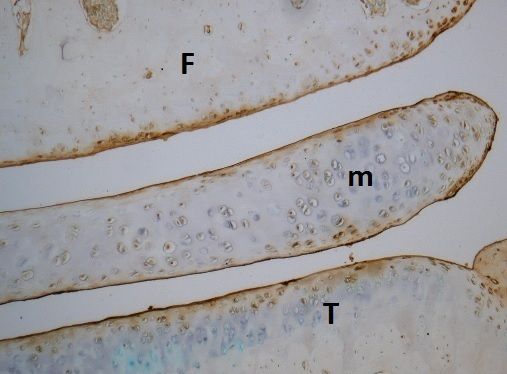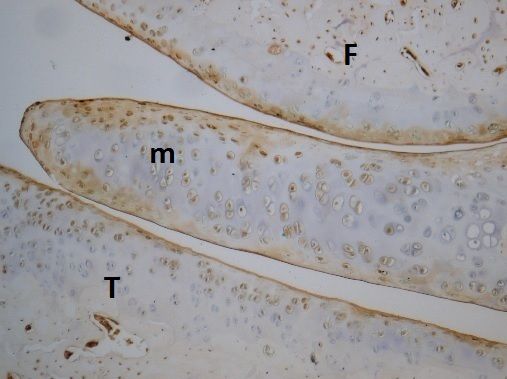Lubricin: New Promise for Joint-Preserving Therapy
Evidence from animal and human studies supports efforts to use the natural lubricant proteoglycan 4 (lubricin) to protect joints threatened by injury or disease, primarily osteoarthritis. The only thing wanted now is clinical proof of the concept. Gregory Jay MD PhD reviews the history and the potential of this new strategy.
The boundary mode of the synovial joint is lubricated during periods of low sliding speed (less than 0.3 mm/sec)1 and high physiologic loads (approaching 5 mPa)2 by hyaluronic acid and lubricin, which prevents the pressurized joint surfaces from adhering to each other.3 Boundary lubricants comprise a layer that is less than the height of the asperities (roughness) of the joint surfaces.4,7,8
Lubricin works together with hyaluronic acid to provide one of the lowest coefficients of friction in all of nature.5-6 A highly O-linked and glycosylated mucinous glycoprotein, lubricin prevents adhesion through steric repulsion, via a layer of brush bristle-like loop and tail structures that are grafted onto the surfaces.7-9 In the case of articular cartilage, surface asperities deform under pressure and are covered by a network of lubricin molecules and conjugates,9 which are secreted onto the articular surface by chondrocytes in the superficial zone10 and into the synovial fluid by synovial fibroblasts.11 (See figure below)
.


Lateral and medial joint compartments from the knee of a rat immunoprobed for PRG4 (lubricin) with a monoclonal antibody and developed using goat anti-mouse secondary antibody conjugated to peroxidase, and counterstained with fast green. Lubricin is detected at the cartilage and meniscus surfaces and within the superficial and upper intermediate zones of cartilage. F: femur; T: tibia; m: meniscus.
• An autosomal recessively inherited disorder of lubricin expression, Camptodactyly arthropathy coxa vara pericarditis (CACP) syndrome, causes severe joint damage in human patients. The condition arises due to truncating mutations that prevent expression of the gene PRG4 (for proteoglycan 4, the chemical name for lubricin). Heterozygote carriers appear phenotypically normal. Predictably, joint lubrication is abnormal in homozygotes. Synovial fluid obtained from several patients with CACP failed to lubricate a bearing system of latex opposed to polished glass that normal human synovial fluid is able to lubricate.3
Patients with CACP are usually born with digital flexor contractions and develop early onset severe arthropathy, usually bilaterally in their elbows, knees, hips, and ankles.12,13 They frequently require arthroplasty early in their third decade of life. Standard anti-inflammatory therapy may be helpful to treat symptoms, and physical therapy is often prescribed. But these patients have unmet medical needs: Immune-modulating therapies are ineffective, because the underlying pathophysiology is due not to autoimmunity but to ongoing mechanical tissue damage.14
• A mutant mouse that recapitulates human CACP syndrome has provided a model to study interventions. The creation of Prg4 knockout mice initially provided the opportunity to understand the histology associated with human lubricin deficiency.15 In the absence of lubricin, their articular surfaces are biofouled with albumin and gamma globulin. In addition, synoviocytes multiply, appear hyperplastic, and encroach upon the articular surface. As these mice age, damage accumulates progressively on their articular surfaces. Excising knee joints from these mice and situating them as the fulcrum of a pendulum has allowed the measurements of whole-joint coefficients of friction, which has confirmed lubricin’s role as an articular lubricant.3
Preliminary studies are underway introducing recombinant human PRG4 (rhPRG4) into the joints of these Prg4 knockout mice. This will determine whether a temporizing treatment is possible that could be translated to humans. Alternatively, an adeno-associated virus containing the mouse Prg4 gene was recently used to overexpress lubricin in both a mouse injury model and in an aging mouse, with promising results.16
• Preclinical rodent studies have examined lubricin treatments for the prevention of posttraumatic osteoarthritis (OA). Lubricin is down-regulated in the presence of inflammatory cytokines, including IL-1 and TNF-alpha.17 Rodent OA models have been used to study the effects of intra-articular (IA) injection of rhPRG4, one week following experimental medial meniscectomy18 and anterior cruciate ligament (ACL) transection.19-20 Lubricin supplementation was significantly effective in preserving cartilage in these experiments.18 One study showed significant improvements in gait symmetry and reduced secretion of urinary CTXII, a biomarker for OA progression.19 Another study of IA lubricin injection, using a forced exercise protocol on rats, showed that those treated with lubricin developed less articular damage than either untreated rats or those injected with IA saline as a placebo. 20
• Traumatized human joints show reduced levels of lubricin. In a cohort of 33 patients, lubricin levels were significantly reduced in the peri-injury period and up to several months after acute ACL injury, as compared to the aspirated normal contralateral joint.21 In the same study, lubricin concentrations from joint aspirations were near normal almost one year following the injury.
• Lubricin prevents chondrocyte apoptosis in vitro and in vivo. Using a reciprocating cartilage disc-upon-disc bearing system, cartilage surfaces lubricated by intervening synovial fluid from CACP patients showed significantly more apoptosis of chondrocytes in the superficial and upper intermediate zone than bearings lubricated with normal synovial fluid. (Apoptosis in these zones has also been observed in the Prg4 knockout mice.)22 But supplementing the CACP synovial fluid with purified lubricin prevented this apoptosis in the same cartilage disc bearings, when subjected to mechanical testing.22 These results suggest that adding rhPRG4 to existing viscosupplementation products may provide chondroprotective benefits to patients with a recent traumatic injury, early osteoarthritis, or CACP syndrome.23
Recombinant human PRG4 is a promising biosimilar that requires additional pre-clinical study before its use in joints at risk for osteoarthritis. Potential therapeutic applications would include the traumatized joint, early OA, and synovitis. This form of therapy can be referred to as tribosupplementation.
References:
REFERENCES
1. McCutchen CW. The frictional properties of animal joints.Wear (1962) 5:1-17
2. Hodge WA, Fijan RS, Carlson KL et al.Contact pressures in the human hip joint measured in vivo.Proc Natl Acad Sci (1986) 83:2879-2883
3. Jay GD, Torres JR, Rhee DKet al.Association between friction and wear in diarthrodial joints lacking lubricinArthritis Rheum. (2007) (56):3662-3669
4. Gleghorn JP, Jones AR, Flannery CR et al.Boundary mode lubrication of articular cartilage by recombinant human lubricin. J Orthop Res. (2009) 27:771-7775. Jay GD, Lane BP, Sokoloff L. Characterization of a bovine synovial fluid lubricating factor. III. The interaction with hyaluronic acid.Connect Tissue Res. (1992) 28:245-255
6. Schmidt TA, Sah RL. Effect of synovial fluid on boundary lubrication of articular cartilage.Osteoarthritis Cartilage (2007) 15:35-47
7. Chang DP, Abu-Lail NI, Coles JM et al.Friction force microscopy of lubricin and hyaluronic acid between hydrophobic and hydrophilic surfaces.Soft Matter (2009) 5:3438-3445
8. Zappone B, Ruths M, Greene GW et al.Adsorption, lubrication, and wear of lubricin on model surfaces: polymer brush-like behavior of a glycoprotein.Biophys J. (2007) 92:1693-1708
9. Schmidt TA, Plaas AH, Sandy JD. Disulfide-bonded multimers of proteoglycan 4 PRG4 are present in normal synovial fluids.Biochim Biophys Acta. (2009) 1790:375-384
10. Flannery CR, Hughes CE, Schumacher BL et al.Articular cartilage superficial zone protein (SZP) is homologous to megakaryocyte stimulating factor precursor and is a multifunctional proteoglycan with potential growth-promoting, cytoprotective, and lubricating properties in cartilage metabolism.Biochem Biophys Res Commun. (1999) 254:535-541
11. Jay GD, Britt DE, Cha CJ. Lubricin is a product of megakaryocyte stimulating factor gene expression by human synovial fibroblasts.J Rheumatol (2000) 27:594-600
12. Marcelino J, Carpten JD, Suwairi WM et al.CACP, encoding a secreted proteoglycan, is mutated in camptodactyly-arthropathy-coxa vara-pericarditis syndrome.Nat Genet. (1999) 23:319-322
13. Ciullini Mannurita S, Vignoli M, Bianchi L, Kondi A, Gerloni V, Breda L, et al. CACP syndrome: identification of five novel mutations and of the first case of UPD in the largest European cohort.Eur J Hum Genet. (2013) [Epub ahead of print]
14. Albuhairan I, Al-Mayouf SM. Camptodactyly-arthropathy-coxavara-pericarditis syndrome in Saudi Arabia: Clinical and molecular genetic findings in 22 patients.Semin Arthritis Rheum. (2013) [Epub ahead of print]
15. Rhee DK, Marcelino J, Baker M et al.The secreted glycoprotein lubricin protects cartilage surfaces and inhibits synovial cell overgrowth.J Clin Invest. (2005) 115:622-631
16. Ruan MZ, Erez A, Guse K et al.Proteoglycan 4 expression protects against the development of osteoarthritis.Sci Transl Med. (2013) 5:176ra34
17. Jones AR, Flannery CR. Bioregulation of lubricin expression by growth factors and cytokines.Eur Cell Mater. (2007) 13:40-45; discussion 5
18. Flannery CR, Zollner R, Corcoran C et al.Prevention of cartilage degeneration in a rat model of osteoarthritis by intraarticular treatment with recombinant lubricin.Arthritis Rheum. (2009) 60:840-847
19. Jay GD, Fleming BC, Watkins BA et al.Prevention of cartilage degeneration and restoration of chondroprotection by lubricin tribosupplementation in the rat following anterior cruciate ligament transection.Arthritis Rheum. (2010) 62:2382-2391
20. Elsaid KA, Zhang L, Waller K et al.The impact of forced joint exercise on lubricin biosynthesis from articular cartilage following ACL transection and intra-articular lubricin's effect in exercised joints following ACL transection.Osteoarthritis Cartilage. (2012) 20:940-948
21. Elsaid KA, Fleming BC, Oksendahl HL et al.Decreased lubricin concentrations and markers of joint inflammation in synovial fluids from patients with anterior cruciate ligament injury.Arthritis Rheum. (2008) 58:1707-1715
22. Waller KA, Zhang LX, Elsaid KA et al. Role of lubricin and boundary lubrication in the prevention of chondrocyte apoptosis.Proc Natl Acad Sci (2013) 110:5852-5857
23. Waller KA, Zhang LX, Fleming BC, Jay GD. Preventing friction-induced chondrocyte apoptosis: comparison of human synovial fluid and hylan G-F 20.J Rheumatol. (2012) 39:1473-1480